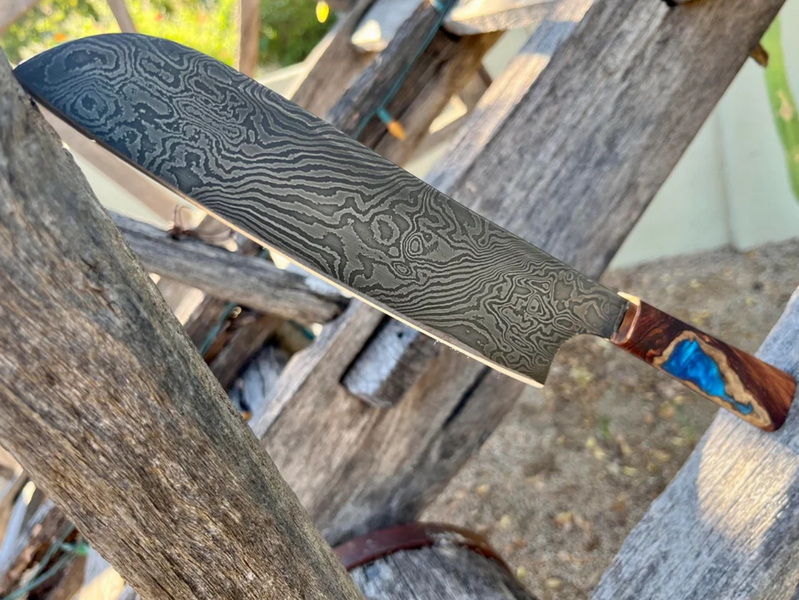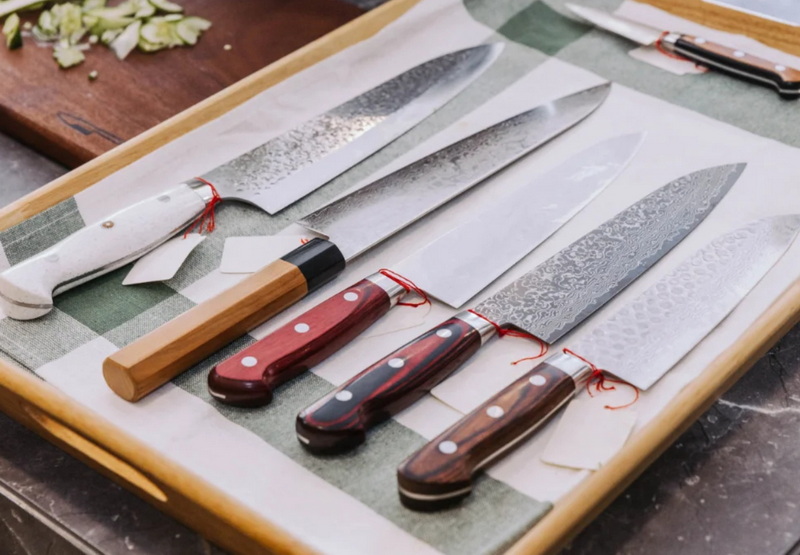Views: 222 Author: Ann Publish Time: 2025-10-16 Origin: Site











Content Menu
● The Rich History Behind Damascus Steel
● The Intricate Manufacturing Process of Damascus Knives
>> Assembling the Steel Billets
>> Heat Treatment and Tempering
● Why Chefs Choose Damascus Knives
>> Superior Sharpness and Edge Retention
>> Remarkable Strength and Durability
>> Resistant to Rust and Corrosion
>> Versatility Across Culinary Tasks
● The Artistic Appeal of Damascus Knives
● Care and Maintenance for Longevity
>> 1. What sets Damascus knives apart from regular kitchen knives?
>> 2. Are Damascus knives worth the price for professional chefs?
>> 3. How do I care for my Damascus knife?
>> 4. Can Damascus knives handle heavy kitchen use?
>> 5. Is sharpening Damascus knives difficult?
Damascus steel knives have long been cherished by chefs around the globe for their extraordinary blend of strength, sharpness, and beauty. These knives are not just cutting tools but also works of art crafted with centuries-old forging traditions combined with modern metallurgy. Their unique layered steel patterns and unmatched performance make Damascus knives highly favored in professional kitchens worldwide. This article delves into why Damascus knives remain the preferred choice for culinary experts by exploring their manufacturing process, advantages, and the value they bring to chefs.

A Damascus knife is a blade forged by layering different types of steel and repeatedly folding them to create many microscopic layers. This process produces a blade with exceptional hardness and flexibility while exhibiting the signature flowing, wavy patterns on the steel surface unique to each knife. These characteristics set Damascus knives apart from regular blades, giving them both functional superiority and aesthetic appeal.
Damascus steel has an illustrious history dating back over one millennium to the Near East, where it was first employed to create legendary swords renowned for their toughness and sharpness. This ancient technique was lost for centuries but revived with modern innovations in metallurgy. Today's Damascus knives preserve this heritage, using high-quality steels combined with contemporary forging and heat treatment methods, producing blades that meet the rigorous demands of professional chefs.
The creation of a Damascus knife is a meticulous and time-intensive process involving several key stages that enhance the blade's strength, appearance, and durability.
First, steel plates of different compositions—typically high-carbon and low-carbon alloys—are cut to size and stacked in alternating layers. These layers are stacked, often 200 to 300 times folded, forming a billet that will be forged into the blade. The contrast between the different steels determines the complexity and contrast of the final pattern.
The billet is heated in a forge to a bright red color (approximately 1,100–1,200°C) to enable forging without cracking. The heated steel is then hammered repeatedly, stretched, folded, and welded to create the combined layers. This cycle is repeated multiple times to build the intricate, tightly bonded layers necessary for the knife's hardness and flexibility.
Once the desired layer count and blade shape are achieved, the blade is ground to its profile. Careful shaping and grinding define the sharp edge and bevel angles required for precise cutting.
The blade undergoes heat treatment, including quenching and tempering, to stabilize the steel's microstructure, enhancing hardness and resilience. Tempering at controlled temperatures reduces brittleness while preserving cutting performance.
To reveal the intricate Damascus pattern, the blade is etched in an acid solution such as ferric chloride. The acid reacts differently with the layered steels, creating contrasting patterns on the surface. Finally, the blade is polished and sharpened to perfection.

Damascus knives are celebrated for their razor-sharp edges that maintain durability over extended use. The layered steel provides a hard cutting edge resistant to dulling, enabling chefs to perform delicate cuts with precision and efficiency.
The multi-layer forging technique combines resilient steel types, giving the blade toughness to withstand heavy-duty kitchen tasks without chipping or breaking. This toughness is crucial for professional kitchens where knives endure frequent and rigorous use.
Many Damascus knives incorporate high-quality stainless steel alloys within the layers, offering good resistance to rust and corrosion. This ensures the blade remains in peak condition even in humid kitchen environments.
The textured surface and layered design minimize food sticking to the blade by reducing friction during slicing. This efficiency speeds up food preparation and improves presentation.
Damascus knives often have handles crafted from premium materials such as stabilized wood, resin, or composites, shaped to provide optimal grip comfort. Their balanced weight distribution enhances control and reduces fatigue during long hours of work.
From butcher knives to paring knives and santoku styles, Damascus knives suit a wide range of kitchen cutting needs. Their precise edges and durability allow chefs to switch effortlessly from intricate slicing to tough chopping.
Beyond functionality, Damascus knives are prized for their unique aesthetics. Each blade's pattern is a fingerprint resulting from the steel layering process, making every knife exclusive. The combination of polished metal patterns with exquisite handle designs transforms the knife into an elegant symbol of culinary passion and mastery.
Damascus knives require proper upkeep to maintain their performance and beauty. It is recommended to wash knives by hand immediately after use and dry them thoroughly to prevent moisture damage. Regular honing keeps the blade sharp, and occasional professional sharpening maintains the edge over years of use. With proper care, these knives can last a lifetime and often become treasured heirlooms.
Damascus steel knives represent the perfect marriage between traditional craftsmanship and modern steel technology. Their unparalleled sharpness, strength, and unmistakable beauty explain why chefs worldwide trust them as indispensable culinary tools. Whether for delicately slicing ingredients or robust chopping, Damascus knives provide superior performance and lasting durability. Investing in a Damascus knife means embracing a culinary companion that enhances every chef's skill and pride in their craft.

Damascus knives are created by layering and forging different steels, resulting in a blade with superior strength, sharpness, unique aesthetics, and resistance to rust.
Absolutely. Their durability, edge retention, versatility, and visual appeal justify the investment for culinary professionals.
Hand wash and dry immediately after use, hone regularly, and send for professional sharpening occasionally to maintain optimal performance.
Yes, the layered steel construction offers exceptional toughness and resistance to chipping, perfect for demanding kitchen tasks.
Sharpening requires care to preserve the layered blade structure, and it is often best done by skilled professionals using appropriate tools.
The Ultimate Professional Knives for Halal Butchery in Middle Eastern Kitchens
Chef Knife Size Guide: Choosing Between 6″, 8″, 10″, And 12″
Custom Knife Handles: How To Design A Chef Knife That Fits Your Hand Perfectly
Chef Knife Surface Treatments Guide: From Polished Migaki To Damascus Patterns
Inside Our Professional Knife Sample Room: Quality You Can See
Universal Knife Block Buying Guide: Modern Acrylic & ABS Knife Holders for Professional Kitchens
Universal Knife Block: The Complete Guide To Modern, Hygienic Knife Storage
The Complete Guide To Red Handle Knife Sets: Style Meets Functionality in The Kitchen
Professional Knives for Halal Butchery And Middle Eastern Cuisine